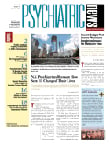Agitation in patients in the psychiatric emergency room may have psychiatric origins or may be due to other causes, and there is no one-size-fits-all approach to managing such behavior, Rachel Glick, M.D., told attendees at APA's annual meeting in Honolulu in May.
"Agitated patients may be dangerous and may not cooperate with treatment, but they may require treatment before a full assessment and diagnosis is reached," said Glick, director of psychiatric emergency services at the University of Michigan Health System in Ann Arbor and a clinical professor of psychiatry at the University of Michigan Medical School.
Agitation is common, has various causes, and is not well studied, she said.
Faced with an agitated patient, look for physical causes first, even if another physician has previously seen the patient, she advised.
"Psychiatric causes are the last resort after physical causes are ruled out," she said. "We should always consider possible medical causes for behavioral symptoms, even if the patient is said to be ‘medically clear.’ "
In fact, Glick prefers not to use the latter term, citing a study that found that 80 percent of patients called "medically clear" had medical problems upon presentation when seen by the emergency department psychiatrist.
A history, vital signs, physical exam, and possibly laboratory studies could help with any diagnosis.
Psychosis may have numerous origins, she reminded her audience. "Acute psychosis is a symptom, not a diagnosis."
Psychosis can be caused by a variety of metabolic disorders (from diabetes to chemistries), neurologic disorders (nonconvulsive status or postictal psychosis), nutritional deficiencies, drug intoxication or withdrawal, or exposure to industrial chemicals like solvents or inhalants, among others, she noted.
Psychiatric causes of agitation can include schizophrenia, bipolar illness, major depressive disorder, anxiety, or personality disorders.
"There is no national standard of care" for patients presenting with agitation, she said. Treatment for such patients depends on expert consensus guidelines.
Verbal intervention is the first recommended course of action, then offers of food or drink, followed by voluntary medication, a show of force, and emergency (involuntary) medication, said Glick. Only if those don't work, is it time to move to physical restraints, locked wards, or seclusion, she stated.
In choosing a drug, she advised considering patient preference and long-term compliance, with oral medications preferable to injections.
For instance, intramuscular haloperidol and lorazepam are the current medications of choice for agitated patients because of their speed of onset. However, haloperidol may cause dystonic reactions, and because it is difficult to maintain patients on the drug, patients must eventually be transitioned to other agents, she pointed out.
"All first-line atypical antipsychotics appear comparable in efficacy, so mode and ease of administration should guide the physician's choice," Glick said.
Involuntary medication has several side effects, aside from any effects that may be caused by the drugs themselves. The patient may be physically injured or psychologically traumatized by the procedure. The patient-physician relationship will likely be harmed, if not broken, and long-term compliance can be compromised.
Ultimately, emergency psychiatry could benefit considerably from more information on choosing and using medications.
"We need to develop an evidence-based approach to agitation," said Glick. "The most helpful thing would be large, double-blind, head-to-head studies, but the drug companies haven't wanted to fund them."

